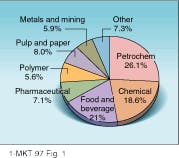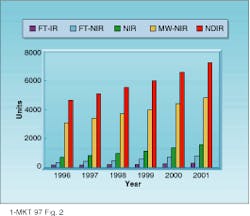Market for process analyzers mirrors growth in high technology
Infrared-based systems are the fastest-growing sector of the process analytical market, as reported in a recently released study by market-research-firm Automation Research Corp. (ARC; Dedham, MA). Fueling growth for process infrared systems (PIRS) are rapid technical advances in hardware and software, greater user acceptance of the technology, and industry`s need for better process control and optimization to increase product yields and quality. Numerous industries are using process infrared systems today (see Fig. 1).
A process infrared (IR) system is a spectroscopic instrument that uses the IR spectrum to measure chemical constituents in a production process. These systems are divided into two main categories--those that operate in the mid-IR spectrum and those that operate in the near-IR spectrum. The unique capability of near-IR wavelengths to measure both transparent and opaque liquids and solids makes this a particularly valuable tool in several industries.
Five techniques
There are five techniques in use today: nondispersive infrared (NDIR), multiwavelength near-infrared (MW-NIR), full-scanning near-infrared (NIR), Fourier-transform infrared (FT-IR), and Fourier-transform near-infrared (FT-NIR). Both the NDIR and MW-NIR techniques use bandpass filters to selectively detect compounds of interest, while the other techniques scan the complete spectrum, using advanced chemometric software to identify specific compounds of interest.
Bandpass-filter systems are the oldest type of process infrared technology in use. The first NDIR system was introduced to the market in 1947 by the Japanese company Horiba. NDIR and MW-NIR systems are typically low cost and represent the largest market for PIRS. Nondispersive-IR systems are used in gas-measurement applications, while MW-NIR systems are commonly used in direct reflectance-measurement of solids. For example, detection of moisture and fat content of snack foods, such as potato chips, is performed by MW-NIR systems.
Full-scanning systems (NIR, FT-IR, and FT-NIR) are relatively new to the market, with the first process NIR systems being introduced in the 1970s. Recovering from initial overwhelming enthusiasm and subsequent market disillusionment because of poor system design and complexity, suppliers now report increasing interest in these systems. Used in various applications, from quality control in the polymer and pharmaceutical industries to octane monitoring in refineries and specialty-gas mixing in chemical plants, these versatile instruments are experiencing a resurgence of interest.
Industrial marketplace
In 1996, the simpler bandpass-filter systems represented almost 85% of all unit sales for PIRS. Their popularity is derived from a number of factors; chief among them are low cost, ease of operation, and simple maintenance requirements--all critical issues for the process-control engineer.
The industrial marketplace is best characterized as very conservative, and technologies such as NDIR and MW-NIR, which have stood the test of time, will remain an important part of the PIRS market. Those who wish to enter this market, though, should be forewarned that the market is mature, with well-established suppliers, and it is becoming more commodity in nature, with decreasing margins.
The real action is taking place in the market for full-scanning systems. For example, it is projected that the average annual compound-unit-sales-growth rate for FT-NIR systems will exceed 19% for the next five years. Fueling this explosive growth are the rapid technical advances that are taking place, coupled with an increasing need among industries to more tightly control their production processes (see Fig. 2).
Impact of optoelectronics
Technical advances in optoelectronics are having a dramatic spillover effect on the development of PIRS. Suppliers of PIRS have begun using these technical advances to provide users with more compact and rugged analyzers at a lower cost. These analyzers also have significantly greater capabilities than predecessors of only a few years ago.
For example, coupling the ability of fiberoptics to transmit near-IR signals with new in situ probe designs is allowing users to monitor several remote points with a single analyzer. Connecting the analyzer unit to remote probes via fiberoptics also enables one to locate the analyzer in a shelter, with the intrinsically safe probes distributed throughout a hazardous area. Many suppliers and users now await the development of inexpensive fibers for transmitting mid-IR signals to extend such capabilities into this critical region for process monitoring.
Fiberoptics is not the only area in which suppliers and users are benefiting. New detectors are operating at higher temperatures with greater sensitivity. The development of acousto-optical tunable filters as wavelength selectors in the near-IR spectrum combined with charge-coupled-device detectors is resulting in very compact instruments with no moving parts. Holographic gratings and tunable laser diodes are also making a significant impact on the design of new PIRS.
The most troubling aspect to all these advances for many PIRS suppliers is the rapid rate at which they are occurring and the subsequent impact they are having on the pricing structure for these systems. The rapid technology advances are forcing suppliers to stay abreast of these technologies with an eye toward incorporating them into future product offerings. This technology tracking can be a drain on resources, and frequently companies have difficulty deciding on where to draw the line and commit to a design that incorporates the technology of today, which may be obsolete in a few short years.
Of even bigger concern is the impact these advances are having on the pricing of full-scanning PIRS. These systems, with an average price of $90,000, are beginning to experience downward pricing pressures by those suppliers who are using some of the latest technology. Only those companies that can keep pace with the technology and incorporate it into their product offerings, providing analyzers at a lower cost to the user, will be able to compete in the future. In fact, this dynamic of rapidly falling prices and numerous technical advances creates a market that is unstable, providing relatively low barriers to entry.
The advantage that current suppliers have is application knowledge, market understanding, and market access. While these are critical components, they do not rule out start-up companies with a good idea, good industry contacts, and a good strategic plan.
Today, customers want products at a lower cost and of higher quality, and management wants to trim costs wherever possible to increase corporate profits. Traditional laboratory sampling and analysis have become too time-consuming and labor-intensive. Older forms of on-line analysis, including gas chromatography, wet chemistry, and knock engines, often do not provide answers quickly enough for accurate and timely process optimization and control. Infrared-based analyzers offer several advantages, including near-real-time results, which provide the opportunity to substantially decrease manufacturing costs, improve product yield, and increase product quality.
Suppliers will be challenged to keep pace with the rapid technology developments occurring in optoelectronics to provide users with increasingly sophisticated and robust instruments at lower costs. It will be critical that suppliers also continue to simplify the operation and maintenance of PIRS. Users will tolerate very little downtime for their process analyzers. If a unit does fail, the supplier must be able to quickly provide a service response.
System manufacturers must also remember that users are not looking for a bag of parts, they want a complete solution to their analysis problem that is straightforward and easy to implement. Therefore, suppliers must remember to focus on selling the customer a solution and not a technology. Those companies that can meet these challenges will reap substantial benefits in this rapidly growing market. o
FIGURE 1. In 1996, the petrochemical industry was the largest purchaser of process infrared systems.
FIGURE 2. Over the next five years unit sales for process infrared systems are expected to grow rapidly.

